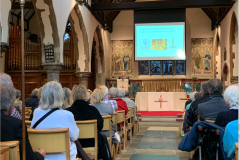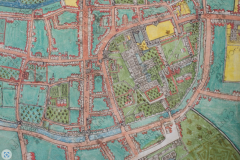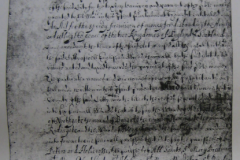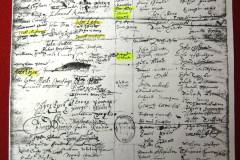Why in 1643 did John Pollyn, a brewer from St George’s parish, and two other men, enter 47 rooms of Lady Wootton’s home (the former Archbishop’s palace) and take away over £300 of goods and 127 sheep, and how many sheep remained after they’d left? The answer to the first part of the question is that Parliament had recently passed the ‘Ordinance for sequestring notorious delinquents estates’ and Pollyn, an alderman, was carrying out Parliament’s instructions by seizing goods from Lady Wootton who was both a catholic and a royalist. We don’t know the answer to the second part of the question but if Pollyn had been doing his work correctly then Lady Wootton might have retained approximately 64 sheep, since about two thirds of the value of an estate could be sequestered. Lady Wootton was just one of many Canterbury citizens mentioned by Professor Jackie Eales in a well attended and entertaining lecture to CHAS members and friends at St Paul’s Church (image 1 below). Professor Eales explained that we are fortunate that many documents from this period of Canterbury’s history have survived and provide us with a wealth of information about the lives of not only the aristocracy and upper echelons of society but also those of tradesmen and other Canterbury citizens. These include a large, coloured estate map of the city liberty (Map/123) held by the Canterbury Cathedral Archives. A central part of this fantastic map is shown in image 2, and Professor Eales made particular mention of Archbishop Abbot’s water conduit in St George’s Street which he gifted to the city. Also of special interest is the Canterbury 1641 poll tax held by the British library (image 3) that provides details such as the names of the head of the household and how much tax each paid on behalf of their family at a basic rate of 6d per head. These and other surviving documents enabled Professor Eales to inform us that between 1600 and 1660, 40 bakers are recorded amongst the Canterbury Freemen, 57 butchers and assorted numbers of plumbers, pewterers, blacksmiths and other metal workers. There were also builders, leather and clothing workers, woodworkers and one or two clock makers, a gunsmith, doctors and surgeons. As in other cities Canterbury contained citizens who were loyal to the King but also supporters of Parliament and another surviving document is the Pro-Parliament Petition from Kent with the Canterbury signatures from 1642 (original in the House of Lords Record Office). A section of this is shown in image 4, and Professor Eales made particular mention of Richard Culmer, sometimes referred to as the most hated man in Kent, who was responsible for the smashing of the stained glass image of Thomas Becket in Canterbury Cathedral and other acts of iconoclasm.
In a link back to CHAS, Professor Eales stated that the sale of Lady Wootton’s goods was directed by another Canterbury citizen, John Cogan, who bought some of the items himself. Cogan’s House is better known to most Canterbury citizens today as Zizzi’s restaurant, but for many years in the mid 20th century it was the private residence of Dorothy Gardner, a historian and chair of CAS (the forerunner of CHAS) for many years.
Click on the images below to enlarge




